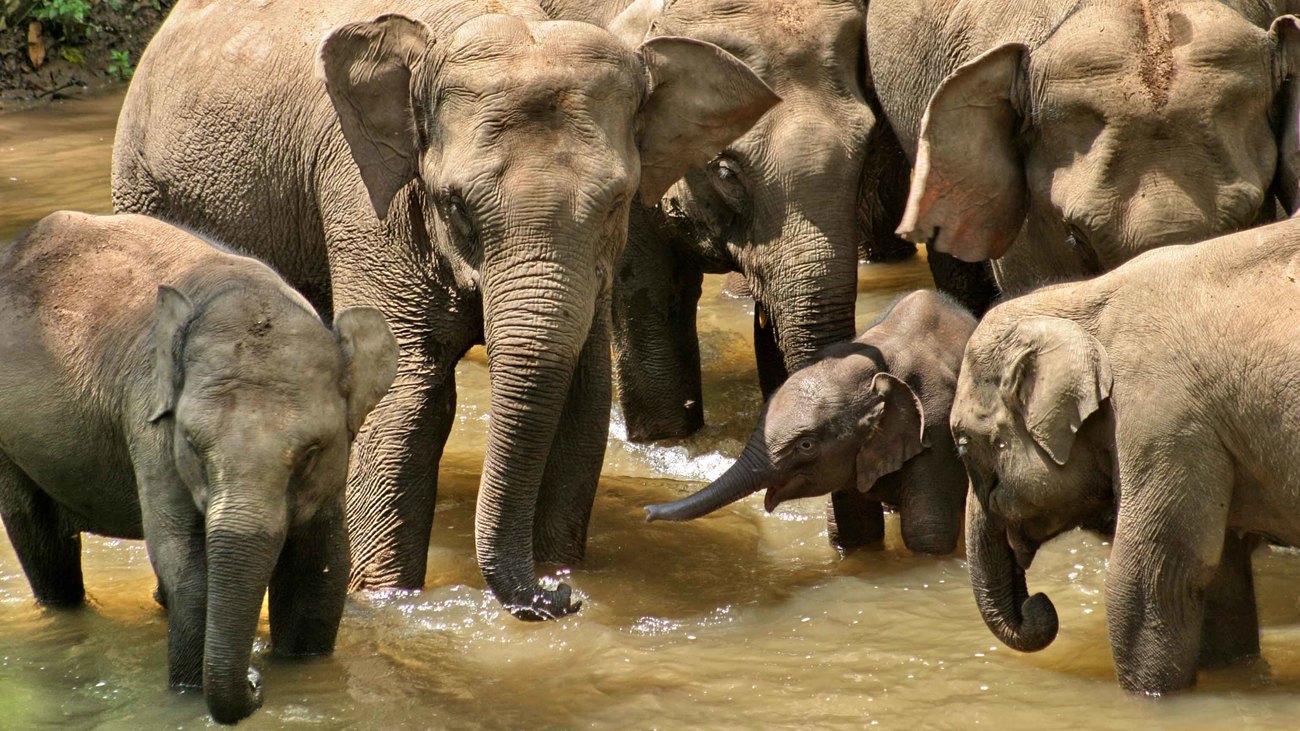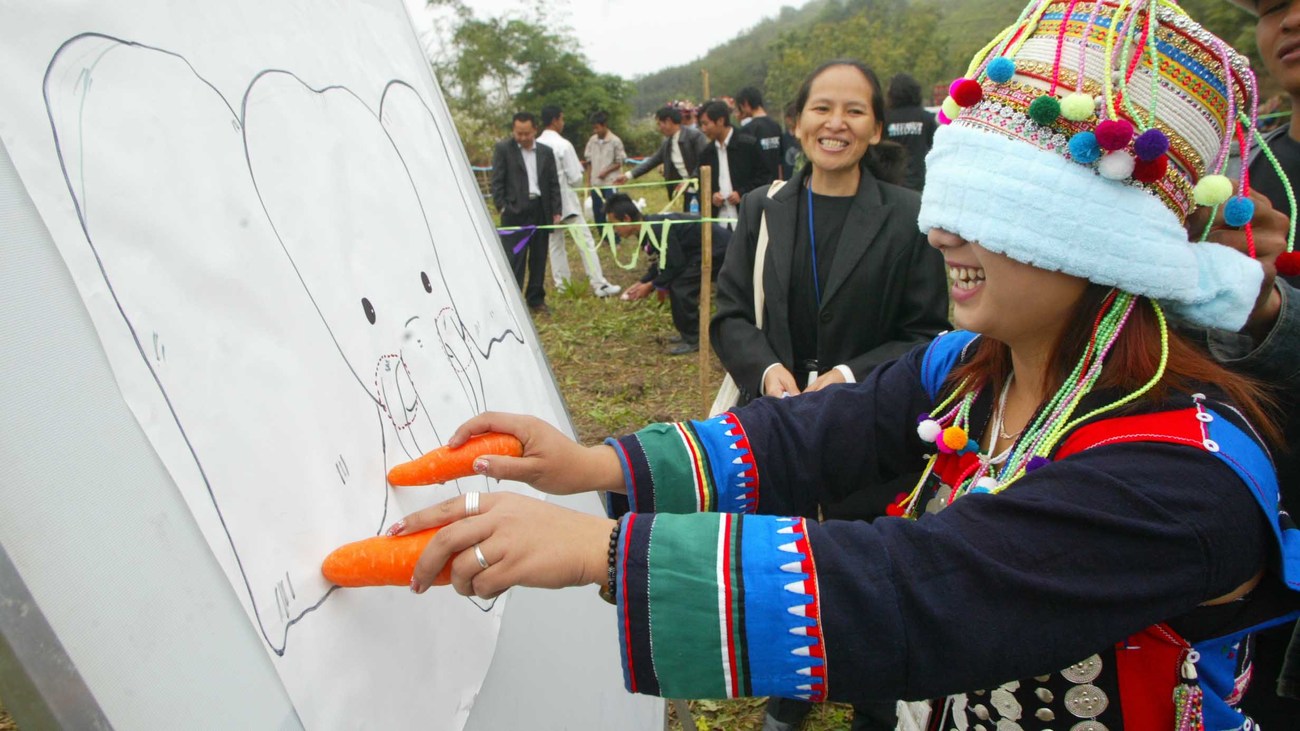admiring and protecting the Asian elephant, a symbol of luck
admiring and protecting the Asian elephant, a symbol of luck

Elephants often appear in old folk tales in southern Yunnan, especially in those of the Dai minority. There is an old local legend that where there were elephants, there were also fewer beasts. To attract elephants, people started planting foods that elephants like near the border between their village and the mountain forest. This way, elephants would reduce the interference of wolves, tigers and leopards. Even to this day, Dai people still view elephants as a symbol of good luck. In spite of occasional incidents of people getting hurt by elephants, there are still old people in Dai villages that will cheer from excitement when they lay their eyes on an Asian elephant and they will even steam glutinous rice and cut sugarcane to make sure that the “guest” is taken well care of.
My hometown of Pu’er is also the home of the Asian elephant. In 1992, a male elephant came to Pu’er, the first wild elephant to do so for over 16 years. Two years later, during the rain season of 1994, a group of five female elephants came to visit and since 1996, this group has never once left Pu’er. The emergence of wild Asian elephants has taken the locals by great surprise. When elephants visit, people will go to watch and feed the elephants as if it was a great festival—even people over 80 years old will sit on tractors to watch the elephants. Everyone views the presence of the elephants as a sign of luck.
It did not take long before people understood that apart from bringing luck, elephants can also bring disaster. Elephants would frequently break into paddy fields, fruit orchards and even residential buildings, causing damage to houses and properties, economical loss and sometimes even death. People and elephants started to compete for food and living space, causing the conflicts to grow bigger and bigger.
Finding ways to coexist
In April 2000, the local government of Pu’er and the International Fund for Animal Welfare (IFAW) jointly launched the Asian Elephant Protection (AEP) project, at the same time that I joined IFAW. As soon as the project was established, we started to visit residents of the villages where elephants were present. It was not until we arrived that we actually understood what kind of a situation the locals were facing. The elephants were not only destroying crops, but also hindering the villagers from living normal lives as they feared for their personal safety.
Once, when I explained that I was there to protect the elephants, I was surrounded and questioned.
“The elephants ate our crops, why are we given such little compensation?”
“If you want to protect the elephants, try taking them to big cities such as Kunming or Beijing and have them live there!”
At first, we would explain the laws and regulations to the villagers, and tell them that the wild Asian elephants were very rare and protected by national law, but I soon understood that without real action, these words were just empty and unconvincing.
Since the start of the AEP project, IFAW has been supporting eco-friendly alternative livelihoods for communities affected by human-elephant conflict. This is an attempt to turn the focus of animal protection from “animals first” to “animal protection starts by focusing on people”. Whether it was providing micro-credit loan assistance to the villagers, carrying out rural financial management training, inviting agricultural experts to teach production technology, holding Spring Festival galas in the villages or organizing pilot villages to carry out production exchanges, it all started with a focus on the people. Thanks to this, the project grew in development and also started to gain a good reputation among the people.

Leadership and community growth
From 2000 to 2005, our project has provided micro-credit loans to more than 210 households in seven villages in the Pu’er region, achieving an average annual income growth of 35%, and achieving a 100% repayment rate through fine project management. What has left me with the deepest impression was witnessing the development of a few local women taking part in the project. Initially, they were never willing to give speeches or take charge.. Now, thanks to the skills they have developed through the project, they are the ones guiding their groups, achieving great improvement, winning recognition and serving as the backbone of their community’s development.
In addition to this kind of community development project that also benefits people, we have launched the first ever community-level early warning system in Yunnan, covering more than 60 villages in areas where elephants are active. In April this year, together with our local government partners, we launched a human-elephant conflict prevention ranger network named “Community Hero”. IFAW designs curriculums and trains rangers on how to carry out training themselves, enabling us to reach more people. The project has mobilized more than 1,600 villagers to strengthen the prevention of human-elephant conflicts after only one quarter of implementation.

Changing minds and promoting long-term coexistence
Over the past 20 years, I have seen my fellow villagers endure complications brought by the elephants, but I have also witnessed endless touching stories of encounters between them and Asian elephants. In the summer of 2015, a baby elephant was abandoned in a village. Authorities rushed to the scene after receiving the news. We were worried about the health of the baby elephant, but also worried that its group would return to look for it. However, when we finally arrived we witnessed something that we had not expected. The baby elephant was hiding in one of the villagers’ firewood shed. Initially, it refused to eat, but the villagers brought milk from different brands to feed it, while others brought fruit and someone had even given the elephant a blanket. The whole village was heartbroken to see the ill little baby elephant. A veterinarian quickly sterilized the baby elephant, gave it an injection and prepared milk powder. Finally, the baby elephant was taken to the Asian Elephant Breeding and Rescue Center for rehabilitation and treatment. As the baby elephant was taken away, an old lady was still stroking its head and feeding it milk, afraid that it would be hungry on the way, while at the same time praying for the life of the elephant. The village, which was not in any way rich, had many times had its farmlands destroyed and the villagers’ life and property safety constantly threatened by the elephants. The villagers both loved and feared elephants at the same time. However, as soon they realized that the baby elephant was in trouble, the villagers’ love overcame their fear.
I still strongly remember a story once told to me by a ranger when he was monitoring elephants far away. He said that when the elephant went into the mountain forest opposite him to find food, he also sat down and started eating his lunch. In addition to the wind blowing through the leaves, he could also hear the birds singing. “They were having their meal over there and I was having mine. At that time I felt pure happiness. This is what the harmony between elephants and people is all about.”
-Dafan Cao, Program Officer, China
Related content
Our work can’t get done without you. Please give what you can to help animals thrive.